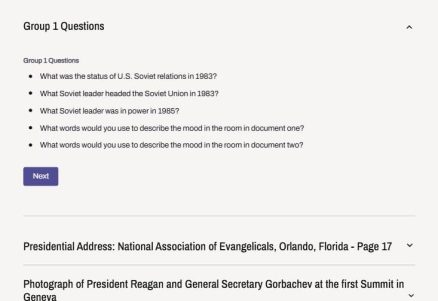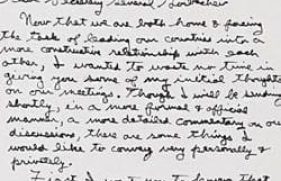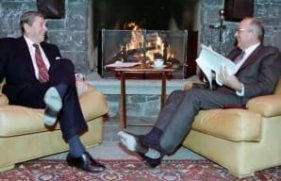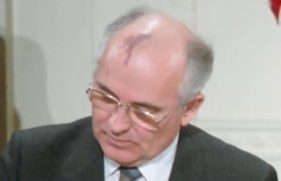The more students know about events and milestones that took place during the 1980s, the greater success they will have with the activity. For advanced classes in grades 9-12. Approximate time needed is two 90 minute sessions (one for the group analysis and one for the presentation of group findings and observations).
Objectives: Students will identify connections between documents and photographs that reveal the role of leadership and diplomacy in ending the Cold War and the special relationship that existed between President Reagan and General Secretary Gorbachev. Students will be encouraged to identify relationships between events, and cause and effect over time.
Instructions: Present the activity to the class so that students can see all of the documents on screen at once. Explain that, as a class, they will determine how the documents are connected to each other. Also, instruct the students to look at the details for each document for further information.
Model careful document analysis with at least two documents in the sequence. Divide the students into groups of 4-5, and direct each group to a computer. Assign each group to complete Box 1, 2, or 3 by responding to the following questions.
Box One: first three documents (page 16 of document 1)
- What was the status of U.S. Soviet relations in 1983?
- What Soviet leader headed the Soviet Union in 1983?
- What Soviet leader was in power in 1985?
- What words would you use to describe the mood in the room in document one?
- What words would you use to describe the mood in the room in document two?
Box Two: documents four and five
- Describe the diplomatic relationship between President Reagan and General Secretary Mikhail Gorbachev.
- Describe some of the major differences in tone between documents four and five.
- Think about the number of audiences a president addresses. What might be some differences between talking to the American people at large and official diplomatic government communications?
Box Three: documents six, seven, and eight
- What are some of the differences between the words delivered at the Brandenburg Gate and the signing of the INF Treaty?
- What connections can be found between political rhetoric and diplomatic action? Is this relationship always easy to explain or define? What lessons have history taught us about President Reagan’s foreign policy strategies?
After students have completed their analysis, allow another 90-minute class session dedicated to each group presenting their observations with a teacher or other designee typing in the findings into a class chart (the lesson should be shown on a classroom projector).
Possible Connections:
- Draft of the President’s address to the National Association of Evangelicals, Orlando, FL (3/8/1983)
- Photograph of President Reagan and General Secretary Gorbachev at the first Summit in Geneva (11/19/1985)
- Letter from Ronald Reagan to Mikhail Gorbachev (11/28/1985)Possible Connection: In 1983, President Reagan had reached out to a number of Soviet leaders, each of whom had died. The Soviet Union was a totalitarian regime with influence around the world. President Reagan focused on defeating the Soviet Union in the Cold War and creating a life of freedom for millions of sufferers under the powerful reach of the Soviet Union. In this famous speech, the language and rhetoric was strong and forceful expressing a clear perspective and uses language such as “evil empire” and “focus of evil in the modern world.” With the rise of General Secretary Gorbachev to power, President Reagan saw an opportunity for working towards his ultimate goal of the elimination of nuclear weapons by developing a strong diplomatic relationship with Mr. Gorbachev. It is clear from the photograph and tone of the letter that Reagan feels a newfound sense of optimism after the first Geneva Summit.
- Letter from Ronald Reagan to Mikhail Gorbachev (page one) (2/16/1986)
- Presidential Address to the Nation: Iceland Meeting (10/13/1986)Possible Connection: Diplomatic relationships are complex and intricate. Clear outcomes can take years to reach. While it is clear in document four that an agreement still has not been met, President Reagan remained strong in his position that he could reach ultimate agreements with the Soviets.
- Photograph of President Reagan giving a speech at the Berlin Wall, Brandenburg Gate, Federal Republic of Germany (6/12/1987)
- Remarks at Brandenberg Gate, Berlin, Germany (President’s Speaking Copy: 6/12/1987)
- Photograph of President Reagan and General Secretary Gorbachev signing the INF Treaty (12/8/1987)Possible Connection: President Reagan believed that in order to eradicate nuclear arms, the United States needed to negotiate from a position of strength. “Peace through strength” was the motto of the Reagan Administration which came to reflect the era of the 1980s and became a symbol for American military prowess and pride.





